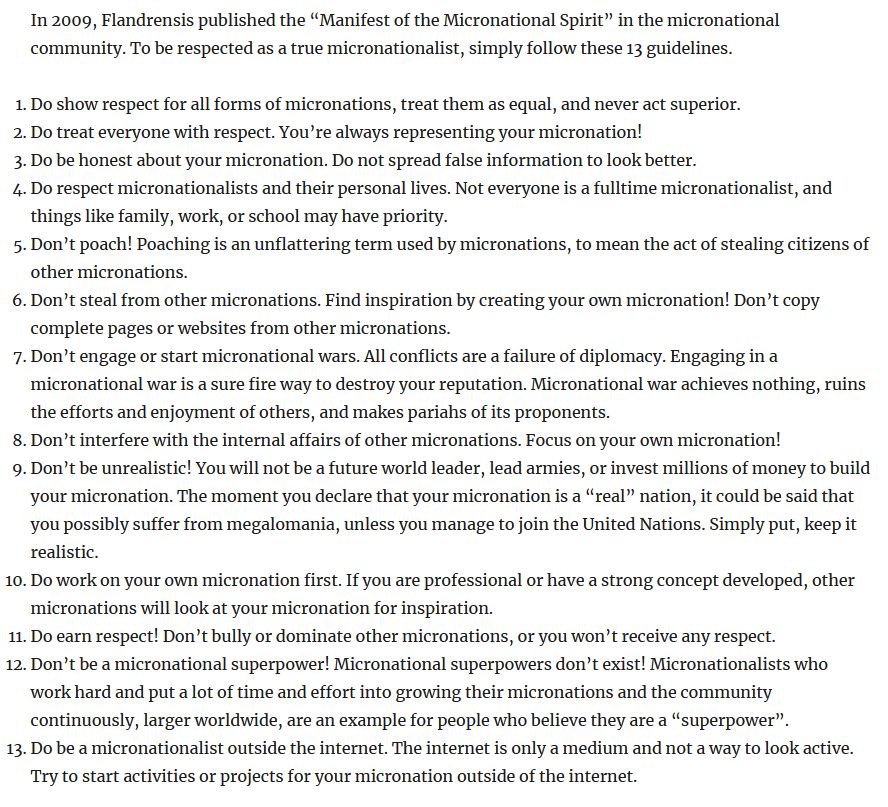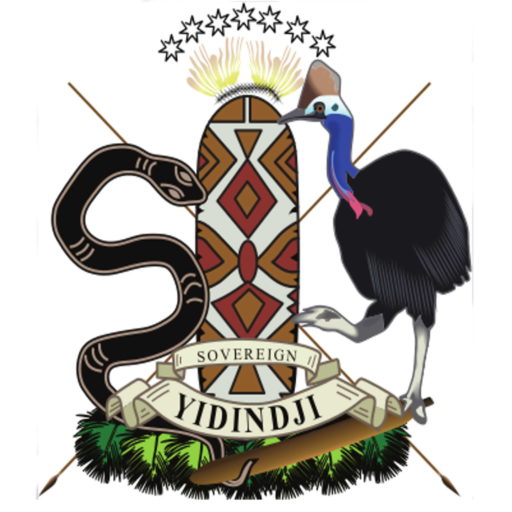There are thousands of micro-nations, principalities and independent mini-states, including various autonomous, indigenous groups all over the world – hence we can only list a fraction of them here. We will continue to add to this list over time.
Below are some compilations of micro-nations gathered by other websites, followed by a list of some specific micro-nations which we feel to be of special interest.
List of Micronations – Wikipedia: https://en.wikipedia.org/wiki/List_of_micronations [accessed 03/08/2022].
Micro-nations – Atlas Obscura: https://www.atlasobscura.com/categories/micro-nations [accessed 17/08/2022].
Micro-Nation World – Journey to World Micro-Nationalism: https://www.micronation.world/documents/ [accessed 03/08/2022].

Grand Duchy of Flandrensis: https://flandrensis.com/ [accessed 07/03/2023].
The Grand Duchy of Flandrensis is a micronation and an environmental nonprofit organization (vzw Groothertogdom Flandrensis). Founded in 2008, they have claims over some islands in Antarctica. Flandrensis is not recognized by any country nor is it their intention to be recognized as a one. As an environmental nonprofit organization, they say their message is more important than their self-declared sovereignty.
Micronationalism: https://flandrensis.com/about/micronationalism/ [accessed 07/03/2023].
How to start a Micronation: https://flandrensis.com/how-to-start-a-micronation/ [accessed 07/03/2023]. In this article, they have published a “Manifesto of the Micronational Spirit” [see below] and they list some useful Facebook groups and links about micronationalism.


Principality of Sealand: https://sealandgov.org/ [accessed 03/08/2022].
Principality of Sealand – What is a Micronation?: https://sealandgov.org/what-is-a-micronation/ [accessed 03/08/2022].
Legal Opinion on Sealand Statehood by Jacobo Rios Rodriguez – Senior Lecturer in Public Law at University of Perpignan Via Domitia
Principality of Sealand: an unrecognized micro-state? (2017)
In order to know whether it is a State, it is necessary to prove the existence of three criteria. There must be a territory, a government and a population. These are three cumulative elements. It is the international custom that provides for this threefold requirement, which has also been codified by the Montevideo Convention of 1933 in its article 1: “The state as a person of international law should possess the following qualifications: a ) a permanent population; b ) a defined territory; c ) government; and d) capacity to enter into relations with the other states”.
Principality of Sealand does not need to be recognized by the other states of international society to be a sovereign state. As stated in the Palmas Island Arbitral Award, “sovereignty in the relations between States signifies independence. Independence in regard to a portion of the globe is the right to exercise therein, to the exclusion of any other State, the functions of a State” (Island of Palmas case, Netherlands, USA, Reports of International Arbitral Awards, 4 April 1928, vol. II, p. 838). To do so, it would be easier to be recognized, to exercise the rights and obligations derived from legal personality. Recognition is not necessary and remains discretionary. The Principality of Sealand, however, states that it was carried out de facto by several States, such as Germany, whose Ambassador visited Sealand in 1978. Or, according to Sealand, more directly by French President Georges Pompidou: the Principality says that he would have sent a letter wishing good luck to the new state. The visit of the representative of the state or the creation of a diplomatic relationship between the states can indeed be an implicit form of recognition if the act is not accompanied by a reservation indicating that it is not. Proof of these acts is required, as well as their scope, even if de facto recognition is more difficult to prove than de jure recognition.
But in any case, recognition is not a condition for being a State, neither in international custom nor in any other norm of international law. Thus, according to Article 3 of the 1933 Convention, “the political existence of the state is independent of recognition by the other states”. Recognition is a discretionary unilateral act, and international law does not make objective reality – the existence of a State-dependent on a voluntarist and random element, recognition by another State.
The question that arises is, therefore, the existence of these three elements in the case of Sealand:
1. In terms of population, there are no quantitative criteria. It can, therefore, be a micro-state, like Sealand, with few nationals. The Vatican is a micro-state with about 1000 inhabitants.
2. As regards the Government, there exists, in the form of a Principality, and exercises several prerogatives which are usually associated with sovereignty, such as the issue of currency. The head of state is Prince Michael.
3. The territorial issue is more complex because it is an offshore fortress located in the North Sea. Two aspects must be distinguished:
(A) The acquisition of territory. In the absence of a territorial sovereign title, the exercise of power is based on the fact that it has been linked to its occupation in international waters since 1966. As the International Court of Justice has said, in the absence of a title such as a treaty of cession: « In the event that effectivité does not co-exist with any legal title, it must invariably be taken into consideration » (Frontier Dispute, Judgment, I.C.J. Reports 1986, p. 587).
(B) The nature of the territory. It is necessary to determine whether the territory of Sealand meets the criteria of the territorial element of the State. The restrictive regulation of artificial islands was only introduced in 1982 by the Montego Bay Convention, 15 years after the creation of the Principality, and this regulation was not codified at the time of the creation of this micro-state. Sealand is an “artificial” territory with a small surface area, created by man, but in an area under a regime of freedom. At the time of its proclamation as a State, in 1967, the territory of Sealand was located in international waters. The territory of a State must have the condition of permanent, and not of “floating” surface. It is therefore up to Sealand to prove this condition of permanent territory. If we go beyond this question, we could indeed speak of the existence of this criterion. The quantitative aspects related to its very small size are not taken into account, for example, Tuvalu is a micro-state of about 26 km2.
As the International Court of Justice has stated: ” No rule of international law, in the view of the Court, requires the structure of a State to follow any particular pattern, as is evident from the diversity of the forms of State found in the world today” (Western Sahara, Advisory Opinion, I.C.J. Reports 1975, p. 43-44). Independently of the difficulty of resolving the question relating to the territorial criterion, and by making a broad interpretation of this criterion, the Principality of Sealand could objectively combine the elements peculiar to a sovereign State, in spite of its peculiarities concerning its maritime character and its lack of recognition.
The Principality of Sealand is one of the territories claiming the condition of most original states of international society. Its controversial character makes it not only a paradigmatic example for scholars of international law, but also an illustration particularly appreciated by students from universities all over the world.
Source: https://sealandgov.org/sealand-notices/legal-opinion-on-sealand-statehood-by-jacobo-rios-rodriguez-senior-lecturer-in-public-law-at-university-of-perpignan-via-domitia/ [accessed 15/08/2022].

Southern Cherokee Nation and the Red Fire People [SCNRFP]: https://statescnrfpgov.ag/home-page [accessed 14/08/2022]. They define themselves as an “international, independent, recognised, sovereign, neutral nation and state“.
SCNRFP – Recognition Page: https://statescnrfpgov.ag/recognition-page [accessed 14/08/2022]. SCNRFP list the various agreements and treaties of recognition they have sought and signed, as well as a history of the international recognition bodies.

Sovereign State of Forvik: http://www.forvik.com/ [accessed 17/08/2022].
“Forvik stands for:
The right to truthful, transparent and accountable governance;
The right to truthful, transparent and accountable governance;
Making our elected representatives our servants, not our masters;
Getting rid of liars, thieves and tyrants in government.
In pursuit of these aims, Forvik undertakes all kinds of activities open to a Sovereign State. Forvik is part of Shetland and demonstrates what Shetland as a whole could be.
The purpose is to challenge the UK government to explain where their perceived authority in Shetland comes from.
These activities include:
Its own parliament (The Ting), able to pass legislation to back its activities, operating under a direct democracy system that gives power to the people, not the politicians. A guiding policy is that money generated will be used for helping people achieve their full potential, to promote and protect sustainable life and to gain freedom from corrupt politicians
Not recognising the UK government or the EU as its superiors
Low or Zero Taxes for Companies and Individuals
Issuing Citizenships and Passports
Issuing its own Currency – the Gulde, a gold-based currency with real value
Issuing its own Stamps
Banking and Financial Services
Company Registrations
Vehicle Registration and Licensing
Ship and Aircraft Registration
Forvik Claims all rights to the seas and seabed in its waters
Duty-free Goods in Local Shops
Duty-free Fuel
All of these are available to Shetland if it simply asserts already existing rights and stops following the officially promoted line that Shetland is part of Scotland. That notion is built on sand – it never happened and only appears to have happened because of deception and subterfuge being perpetrated at the highest level. One aim of the Forvik project is to expose that deception and make the government accountable.”

Sovereign Yidindji Government: https://www.yidindji.org/ [accessed 03/08/2022].
Sovereign Yidindji Government – Official Documents: https://issuu.com/yidindji [accessed 03/08/2022].
“The Yidindji nation is a rainforest-based society situated in what the rest of the world would describe as north east Australia. Our capital city is Gimuy [Australian description: Cairns], and the Yidindji territory is divided up into eight cantons. The Yidindji nation is a pre-1770 society. It has a system of authority, land tenure and decision-making, and its sovereignty has neither been ceded nor extinguished.
“The intention behind the Yidindji Nation’s legal personality is to help settle the past and secure the future for everyone on the Yidindji Territory, through a successfully concluded formal agreement between the Yidindji Government and the Commonwealth of Australia.”
